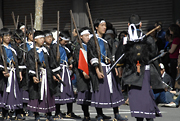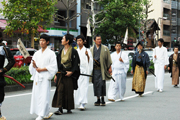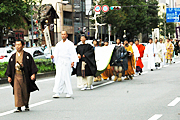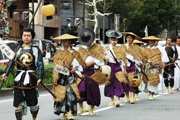
The Jidai Matsuri Festival
The Jidai Matsuri Festival is one of the three most renowned festivals of Kyoto, together with the Aoi Matsuri Festival and the Gion Matsuri Festival, and it is an important and large-scaled festival held at Heian Shrine in Kyoto.
The festival started in 1895 as a commemorative event to celebrate the foundation of Heian Shrine as well as the 1,100th anniversary of the relocation of Japan’s capital to Kyoto in 794. The first Jidai festival was held on October 25, however, starting the following year, it has been held on October 22, which is the same day that Emperor Kanmu relocated the capital of Japan from Nagaoka-kyo to Heian-kyo, now known as Kyoto, 1,100 years ago, considering the day as the “Birthday of Kyoto”.
Processions with two mikoshis (portable shrines) with the divine spirits, one of Emperor Kanmu and the other of Emperor Koumei, take them around the city and show them the stability, prosperity and evolution of Kyoto. They are accompanied by 20 processions representing eight different periods, which start with the Meiji Restoration, followed by the Edo period, the Azuchi-Momoyama period, the Muromachi period, the Yoshino period, the Kamakura period, the Fujiwara period and the Enryaku period. The processions, with a total of about 2-km length, are consisted of about 2,000 participants, cows and horses, and take 3 hours to finish. Over 12,000 items including the costumes, ritual utensils and furnishings in the processions were made based on rigorous background research, and the detailed parts of each period were reproduced with using Kyoto’s traditional skills and techniques. These lavish processions look as if they had come out of the “picture scrolls” of those ancient times.
The Jidai Matsuri Festiva Schedule
- October 15
-
- 1:30 pm
-
Jidai Matsuri’s Appointment Ceremony / Heian Shrine
About 500 heian-kou-shain (residents of Kyoto) who have been selected to represent main historical characters in the processions pray to the gods for the event to proceed smoothly and successfully, and each of them is given a sen-jyo (appointment letter) from the guji (chief priest).
- 3:00 pm
-
Jidai Matsuri’s Celebratory Dance “Ashi-gatame” Performance / Heian Shrine
A folklore linear dance performed at the precincts of the Heian Shrine by 300 female dancers in the same costume.
- October 21
-
- 10:00 am
-
Jidai Matsuri’s Eve Festival with kenka (offering of flowers) / Heian Shrine
A ceremony held at Heian Shrine with offering of flowers to pray for another successful Jidai Matsuri Festival for the year.
- October 22
-
- 7:00 am
-
Jidai Matsuri’s Opening Ceremony / Heian Shrine
The chief and the bugyos (Japanese magistrates) of the processions attend the opening ceremony, with the chief reciting a sai-bun (address to the gods) on behalf of the heian-kou-sha (residents group of Kyoto).
- 8:00 am
-
Shikou-Sai Ceremony / Heian Shrine
Transferring the divine spirits of Emperor Kanmu and Emperor Koumei from the Heian Shrine to two mikoshis (portable shrine).
- 9:00 am
-
Departure of Shiko Procession / Heian Shrine to Anzaisho at Imperial Palace
The Shinkou procession with two mikoshis departs the Heian Shrine, aiming to arrive at the Anzaisho (provisional palace for the Emperor's outings) of the Imperial Palace at around 10:00 am.
- 10:30 am
-
Anzaisho Ceremony / Anzaisho at Imperial Palace
Parishioners and representatives of the Kyoto residents attend this ceremony. The offerings of food to the gods are served by shinsen-kou-sha (those who are dedicated to offer food to the gods), and also kenka (the offering of flowers) is conducted by Shirakawa-me (women from Shirakawa, where traditionally they sold flowers with carrying them in a basket on the head).
- 12:00 pm
-
Processions’ Departure / Konrei-mon Gate at Imperial Palace
The rest of the Jidai Matsuri’s processions depart from Konrei-mon Gate of the Imperial Palace, heading to the Heian Shrine. Celebratory dance performances will be held at Oike-tera-machi at 1:00 pm, then in front of the Heian Shrine at around 2:00 pm.
- 4:00 pm
-
Daigokuden Ceremony & Ceremony for the Return of Divine Spirits / Heian Shrine
After all the processions arrive at the Heian Shrine, the two mikoshis with the divine spirits are escorted to the Daigokuden (main building of the shrine). Upon their arrival, the Sanmi (Third Rank) from the Procession of Civil Official in the Enryaku Period recites an address to the gods on behalf of all the attendees. Then, the spirits of the emperors will be transferred back to the honden (inner shrine), which brings an end to the festival.
- October 23
-
- 10:00 am
-
Jidai Matsuri’s Day-after Festival / Heian Shrine
The success and the end of the festival will be reported to the gods at the shrine, and all the ritual utensils will be stored until the next festival.
- 10:00 am
※ Reiwa first year October 22, the Upon "enthronement ritual ceremony of the main hall" Tokigyo at the Imperial Palace palace, October 21 era Festival the day before Festival, 22 days era Festival main shrine Festival, 26 days era customs matrix (rainy weather postponed) · 27 days will be the era Festival at a later date Festival Tokigyo.
Course of the parade
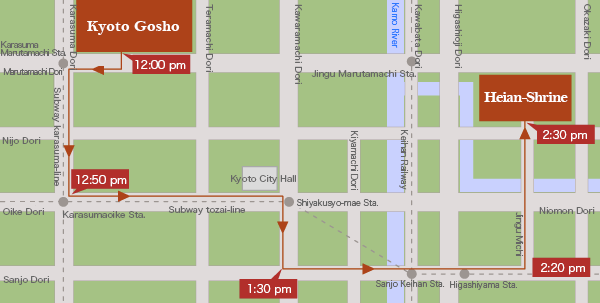
The main supporter of the Jidai Matsuri Festival is the Heian-kou-sha, which is an organization made by the residents of all areas of Kyoto City. The whole city is divided into 10 groups, and amongst them, each group is in charge of its own processions every year. Moreover, each group is consisted of several school districts, and the casting of the processions is decided within the districts on a rotation basis. Thus, some school districts are in charge of assigning some roles every year while others get their turn once in ten years. On the morning of October 22, the day of the processions, those who in the traditional costume will first go around within their school districts to make their debut. However, the times for this type of debut parades are various and also some school districts don’t seem to conduct these parades, so if you come across with one, it means that you are lucky.
contents,turn,the highlight of Jidai Matsuri Festival
※開催年によって、一部内容が異なる場合がございます。
Procession of ‘Meiyo Bugyo (Honorable Commissioners)’
- Governor of Kyoto Prefecture
- Mayor of Kyoto City
- Chairperson & Vice-Chairperson of the Kyoto City Assembly
- Chairperson of the Jidai Matsuri Festival Supporter’s Association
- Chairperson of the Kyoto’s Chamber of Commerce and Industry
- Flag of the Jidai Matsuri Festival
- So Bugyo (Grand Magistrate)
Meiji Restoration Period
Procession of ‘Ishin-kinnou-tai (armed force of farmers who joined the imperial loyalist troop during the restoration period)’
A fife and drum band known for their vibrant sounds of drumming and flute tunes leads the processions representing the Meiji Restoration Period. The sound and tunes leaves such an impression on spectators that it could be said that it is a symbol of the Jidai Matsuri Festival. During this period, some farmers from Yamaguni-mura (now known as Keihoku, Ukyo District of Kyoto City) voluntarily formed an armed force called Yamaguni-tai, and later joined the imperial loyalist troop. This procession is modelled after this armed force, with wearing a sansai-baori (battle surcoat with a split hem) on top, a yoshitsune-bakama (a kind of hakama, men's traditional divided skirt) on bottom, layered underneath with tsutsu-sode (tight-sleeved kimono). They also wear a headband or shaguma (long-hair wig in bright red for warriors) on the head, covering their legs in kyahan (gaiters), and wearing tabi (Japanese socks) and waraji (straw sandals) on their feet. Armed with a katana, they have their guns at the ready.
Procession of ‘Bakumatsu-Shishi (samurai patriots during the restoration period)’
The main characters of the Meiji Restoration make an appearance one after another, escorting and guarding the procession of ‘Shichi-kyo-ochi (seven court nobles who were expelled from Kyoto during the period)’ between them.
- Kogoro Katsura
- Later known as Takamitsu Kido. A feudal retainer of the Choshu Domain, known as one of the ‘Ishin-san-ketsu (Three great contributors of the Meiji Restoration)’ together with Takamori Saigo and Toshimichi Okubo.
- Kichinosuke Saigo
- Later known as Takamori Saigo. A feudal retainer of the Satsuma Domain, who formed the Sacho-domei (alliance between the Choshu Domain and the Satsuma Domain) with help of Ryoma Sakamoto as a mediator, and later on played a major role in making the Edo Castle surrendered without spilling blood.
- Ryoma Sakamoto
- e contributed largely to the formation of the Sacho-domei and the Taisei-hokan (restoration of imperial rules), however, was assassinated before achieving his ambition and seeing them realised.
- Shintaro Nakaoka
- He made every effort in the restoration with his comrade from the same domain, Ryoma Sakamoto.
- Shinsaku Takasughi
- A feudal retainer of the Choshu Domain, known as one of the two greatest pupils of Shoin Yoshida at the Shoka-son-jyuku (private school in Shoka-son Village, Choshu Domain) along with Genzui Kusaka.
- Shoin Yoshida
- A feudal retainer of the Choshu Domain, who devoted himself in nurturing many bright minds including Shinsaku Takasugi and Hirofumi Ito at the Shoka-son-jyuku.
- Torataro Yoshimura
- A feudal retainer of the Tosa Domain, who led the Tehchu-gumi (armed force formed under the movement to overthrow the Shogunate), raised the army, but then was defeated by the army of the Shogunate.
- Mikisaburo Rai
- The son of a Confucian scholar Sanyo Rai, Worrying the future of the country and determined to do something to change the situation, he often gathered with other comrades and criticised the Shogunate administration actively.
- Unbin Umeda
- A feudal retainer of the Obama Domain, who was versed in Japanese and Chinese literature. He opened the Konan-jyuku (private school in the current Shiga Prefecture), and educated and guided his pupils with the virtue.
- Sanai Hashimoto
- A feudal retainer of the Fukui Domain, who had mastered the Western medicine and also had a great knowledge in Western learning and current affairs. For his talent, he was invited to become a part of the domain administration, and made every effort to do it well. In this procession, he is in a traditional Japanese travel outfit.
- Tadahiro Konoe
- He became Sadaijin (Minister of the left) under Emperor Komei, but resigned later due to an incident, and decided to become a priest. However, later in life he returned to secular life, and became Kanpaku (chief adviser to the Emperor). In this procession, he appears as Kanpaku, wearing sokutai (traditional Japanese court dress), accompanied by zuishin (attendant) and toneri (servant).
- Kintomo Anegakoji
- Along with Sanetomi Sanjyo, he dedicated himself to the cause of overthrowing the Shogunate. In this procession, he wears ikan (traditional Japanese court dress, less formal than sokutai).
- Sanetsumu Sanjyo
- He was appointed to Gon-dainagon (acting chief councillor of state) in 1824, and then to Naidaijin (Minister of the Interior) in 1857. After his death, he was enshrined in the Nashiki Shrine as the deity. In this procession, he is wearing noshi (everyday clothes for noblemen).
- Tadayasu Nakayama
- The maternal grandfather of Emperor Meiji. He once was Dainagon (chief councillor of state), but after resigning, he was appointed to a very important position called Hohitsu, which directly supports the Emperor’s administration, and was later awarded Ju-ichii (Junior First Rank). In this procession, he wears ko-noshi (clothes less formal than noshi).
- Kuniomi Hirano
- A feudal retainer of the Fukuoka Domain. He was a dedicated loyalist and made every effort to spread the movement to overthrow the Shogunate, however failed in the Teradaya incident, and sent to prison.
Procession of ‘Shichi-kyo-ochi (Seven court nobles who were expelled from Kyoto)’
In 1863, the Coup of August 18 took place and seven court nobles who had planned to overthrow the Shogunate were expelled from Kyoto. The procession reproduces the time when the seven court nobles in a mino (straw coat) fled to the Choshu Domain, guarded by the loyalists in armour including Izumi Maki.
- Court noble Sanetomi Sanjyo
- Court noble Suetomo Sanjyo
- Court noble Michitomi Higashikuze
- Court noble Motoosa Mibu
- Court noble Takauta Shijyo
- Court noble Yorinori Nihikikouji
- Court noble Nobuyoshi Sawa
- Loyalist Izumi Maki
- Loyalist Genzui Kusaka
Edo Period
Procession of Tokugawa Shogunate’s representatives to visit the Imperial Palace>
The Tokugawa Shogunate ensured to send their messengers to the Imperial Palace without fail to show the utmost courtesy whenever some important ceremonies were held at the Imperial Court. Especially when enthronement ceremonies took place at the palace, the representative of the Shogunate was sent in a particularly lavish procession, accompanied by many servants dressed in luxurious clothes. The highlight of this procession is the performance by spear-bearers, servants holding parasols or lacquered boxes at the top of the procession, which shows a close resemblance to what the procession once must have been like in the Edo period.
Procession of Renowned Ladies in the Edo period
- Kazu no Miya
- he eighth daughter of Emperor Ninkou, who later became the lawful wife of Iemochi Tokugawa, the fourteenth Shogun of the Tokugawa Shogunate. She is the only imperial princess in the history of Japan to have married one of her subjects and left the capital. In this procession, she appears in juni-hitoe (twelve-layered ceremonial kimono), which she used to wear at the Imperial Palace, and is accompanied by female servants.
- Rengetsu Otagaki
- A Poet from the end of Edo period, who excelled in not only writing but also pottery. She became a nun later in life, and was called Rengetsu. In this procession, she is portrayed as her younger self when she was a poet.
- Wife of Kuranosuke Nakamura
- The wife of a wealthy man called Kuranosuke Nakamura. She is known for an anecdote of Isho-kurabe (dress competition), where she appeared in shiromuku (immaculate white kimono) with uchikake (long outer garment) made of black Japanese Habutae silk of the highest grade on top while all the other wives of wealthy men were dressed in very colourful dresses. By dressing her servants in very colorful clothes which was as lavish as that of the other wives, she managed to bring the color of her own dress out into prominence even more.
- Gyokuran
- The wife of a painter called Ike no Taiga. She was known as a painter herself, and was also excel in Japanese waka poetry.
- Kaji
- Gyokuran’s grandmother, who ran a mizu-cyaya (roadside tea-house) in the Gion area. She was a poet and edited a collection of waka poetry called ‘Kaji-no-ha’.
- Yoshino Tayu
- Tayu refers to the highest rank of courtesans. It is said that she attracted people like a magnet not only for her beauty but also for her talents in various forms of art including waka poetry, haiku poetry, koto (Japanese harp), calligraphy and sado (art of ceremonial tea-making). She is also known to have contributed a mountain gate to the Jyosyoji Temple. In this procession, she is dressed in the costume as geisha.
- Izumo no Okuni
- A shrine maiden of the Grand Shrine of Izumo. It is said that she was the creator of kabuki.
The processions of renowned ladies from different periods are some of the highlights of this festival for from head to toe their clothes and hairstyles that were in fashion at the time have been reproduced as they were. All the hairstyles were made with using their own hair by yushoku-biyoushi, which is an occupation engaged in studying traditions such as traditional events, manners and customs, and costumes, and transmitting them to the future generations.
-
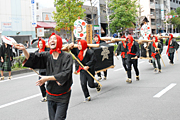
Tokugawa Shogunate’s representatives to visit the Imperial Palace
-
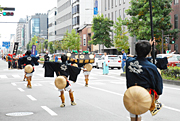
Renowned Ladies in the Edo period Kazu no Miya
-
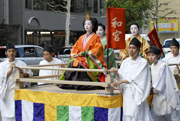
Renowned Ladies in the Edo period Rengetsu Otagaki
-

Renowned Ladies in the Edo period Yoshino Tayu
-
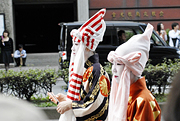
Renowned Ladies in the Edo period Pupil of Izumo no Okuni
-

Renowned Ladies in the Edo period Pupil of Otagaki Rengetsu
Azuchi-Momoyama Period
Procession of ‘Houko-sancho (Toyotomi Shogunate’s visits to the Emperor)’
It is said that out of all those visits to the Emperor made by the Toyotomi Shogunate, two were particularly known for having a large number of people in the processions. One of them is Hideyori Toyotomi’s first visit to the Imperial Palace in May 1596 and the other is his another visit to report his coming of age to the Emperor in September of the following year. This procession reproduces how those processions looked like at the time. The costume worn in this procession is called ‘Ichinichi-bare (one-day formal occasion)’ which was allowed to wear only on these particular occasions, and their ikan (traditional Japanese court dress) as well as the style of the sword they carry make them look unusual and more like samurais.
Procession of Nobunaga Oda’s Army to Kyoto
This procession reproduces how Nobunaga Oda led an army to Kyoto in September 1568, which was driven by his ambition to bring the whole country under one rule of his own.
- Nobunaga Oda
- He overthrew the Muromachi Shogunate in 1573, however he was attacked and killed by Mitsuhide Akechi at the Honno-ji Incident right before taking the control of the whole country.
- Hideyoshi Hashiba
- Later known as Hideyoshi Toyotomi. He was born as a farmer, but later he was noticed for his talent and dedication by Nobunaga Oda while serving him. After Nobunaga Oda’s death, Hideyoshi accomplished to bring the whole country under one rule.
- Nagahide Niwa
- One of Nobunaga Oda’s liegemen. He had a very close relationship with his lord Nobunaga, which can be shown by one of the letters of his name ‘naga’ given by Nobunaga and also by Nobunaga’s describing him as ‘a friend and a brother’.
- Kazumasu Takigawa
- One of Nobunaga’s liegemen.
- Katsuie Shibata
- His wife Oichi no Kata was Nobunaga’s sister.
Muromachi Period
Procession of the Administrators of the Muromachi Shogunate
In this procession, the Ashikaga Shogun on the horseback is not wearing armour but wearing kogusoku, which is rather casual dressing, with gold brocade, and an eboshi (headgear worn by nobles), and is accompanied by the Syuyosyu family, who were in charge of the administration of the shogunate. There are also some characters including masters and doctors that cannot be seen in any other processions.
Procession of Customs in the Muromachi Period
This procession reproduces ‘Furyu-odori’, which is a style of dance started during the Muromachi period. The dance performance was often held by local businessmen in Kyoto, and it is consisted of Furyu parasols at the centre, ‘Naka-odori’ performed by children and ‘Soku-odori, performed in kosode (quilted silk garment). At the time it was performed only by male dancers and they usually participated in eccentric disguise or flashy and gaudy clothes for women. This dance spread to all over Japan, from which various art and performance were born. This includes the Bon-odori Dance, which continues to be loved and enjoyed at festivals to this day.
-
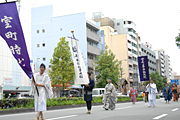
Procession of the Administrators of the Muromachi Shogunate
-

Procession of Customs in the Muromachi Period
Yoshino Period
Procession of Kusunoki Family
This procession reproduces how the family of Masashige Kusunoki led Godaigo Emperor from Oki where he was living in exile to Kyoto in 1331. It is said that it was the most important event during Masashige Kusunoki’s lifetime. The highlight of this procession is its wide variety of beautifully designed arms and armours.
Procession of Renowned Ladies in the Yoshino period
- Yodogimi
- Hideyoshi Toyotomi’s concubine. In this procession, she is holding a fan and wears layers of clothes for outings including uchikake (lavish long outer garment) and kosode (quilted silk garment), fastened with an embroidered obi (girdle).
- Fujiwara Tameie no Shitsu
- Tameie Fujiwara’s concubine and was called ‘Abutsu-ni’ after becoming a nun. She is the author of a book called ‘Jyuroku-ya Diary’. In this procession, she is holding a Bunjyo cane with a complaint letter attached, wearing a straw hat with veil and also Hantabi socks and straw sandals on feet, and carries a safe travel amulet hanging across her body. Her servant carries a karahitsu (six-legged Chinese-style chest) containing all the necessities to travel.
- Shizuka Gozen
- Yoshitsune Minamoto’s mistress. In this procession, she is in the costume of Shirabyoshi (traditional Japanese dancer), wearing mizu-boshi (everyday garment), hitoe-kosode (quilted silk garment), white kiri-bakama (short hakama), and a tate-eboshi (eboshi headwear with a peak), and holding a tsuzumi (hand drum). She is accompanied by a young girl servant holding a silk parasol over her.
- Ohara-me
- Women from Rakuhoku Ohara (area in the north of Kyoto) who came to the city to sell firewood and coals that are held on their head while walking around.
- Katsura-me
- 桂川をこえて鮎や飴を売り京の町に来る販女です。また、巫女の一種でもあり、婚礼や出産など、家の祝い事に訪れることもありました。頭に巻かれた白い布「桂包(かつらづつみ)」は、皇后から頂いた布であったと言われています
-

Procession of Kusunoki Family
-

Procession of Renowned Ladies in the Yoshino period Yodogimi
-

Procession of Renowned Ladies in the Yoshino period Shizuka Gozen
-

Procession of Renowned Ladies in the Yoshino period Ohara
Kamakura Period
Procession of Yabusame at Jyonan Imperial Villa
Yabusame is a type of mounted archery started in the Heian period and it was practiced often as one of the skills that samurai should have possessed. To perform or compete, an archer on a running horse shoots three arrows at three targets on a riding ground. This procession reproduces an event held at the Jyonan Imperial Villa by Gotoba Emperor in 1221 in order to recover the authority of his Imperial Court, with 1,700 samurais summoned from more than 10 domains in the Kinki region. There are five groups of samurais with archers in hunting clothes at the centre of each group.
-

Procession of Yabusame at Jyonan Imperial Villa
Fujiwara Perio
Procession of Fujiwara Family to visit the Emperor>
This procession reproduces the time when the era of the Fujiwara family flourished, which started in the mid-Heian period. The characters in this procession wear summer clothes.
Procession of Renowned Ladies in the Fujiwara Period
This procession is represented by three of the five Kyoto hanamachis (geisha quarter), and the geishas from these three hanamachis take turns in attending the procession.
- Tomoe Gozen
- Yoshinaka Minamoto’s mistress, known to have fought beside him as a female military commander. In this procession, she is wearing armour and a celestial crown, carrying a sword around her waist, and holding a longsword in hand. Her servants wear an ori-eboshi (folded headwear for court nobles), haramaki (belly band) and a small sword, and each holds a bow or a ladle to water horses.
- Yokobue
- A zoshi (a woman who performs small jobs in the Imperial Court) served Kenreimon-in. She fell in love with Tokiyori Takiguchi, and after he became a priest, she followed him and became a nun. In this procession, she wears uchighi (servant’s clothing) and a straw hat, which she was wearing when she went to Saga to visit Tokiyori.
- Tokiwa Gozen
- Yoshitomo Minamoto’s concubine and the mother to Ushiwaka (later known as Yoshitsune Minamoto). This procession reproduces Tokiwa-gozen travelling to Rokuhara with three children including Ushiwaka after Yoshitomo died.
- Muraski Shikibu
- The author of the ‘Genji-monogatari (Tale of Genji)’. In this procession, she is informally dressed as a lady of the Imperial Court.
- Sei Shonagon
- The author of the ‘Makura-no-soshi (Pillow Book)’. In this processon, she is wearing a formal dress of a court lady.
- Daughter of Kino Tsurayuki
- She is wearing uchiki (servant’s clothing), hitoe-kosode (quilted silk garment), short hakama in crimson and holding a small branch of plum tree in hand.
- Ono no Komachi
- She was a talented poet and it is said that she was a rare beauty. Her costume in this procession is unique in the early Heian period, and was made with reference to a sculpture of goddess at the time.
- Wake no Hiromushi
- It is said that she was very merciful and strove to raise many orphans. In this procession, she appears to have returned to secular life and holds a fan. She’s accompanied by two each of male and female orphans.
- Kudara O Myoshin
- She served to Kanmu Emperor as the chief of court ladies, which was the highest rank of court ladies at the time. In this procession, she wears kara-koromo (short coat for noblewomen) and dresses in Chinese style, holding a sashiha (a large fan-shaped object) in hand and being accompanied by waiting maids.
-
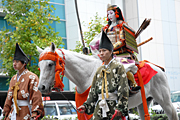
Procession of Renowned Ladies in the Fujiwara Period Tomoe Gozen
-

Procession of Renowned Ladies in the Fujiwara Period Tokiwa Gozen
-

Procession of Renowned Ladies in the Fujiwara Period Muraski Shikibu&Sei Shonagon
-

Procession of Renowned Ladies in the Fujiwara Period Ono no Komachi
-
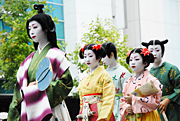
Procession of Renowned Ladies in the Fujiwara Period Wake no Hiromushi
Enryaku Period
Procession of Military Officers in the Enryaku Period
The general in command of this procession is Sakanoue no Tamuramaro, and the procession reproduces how the military officers returned in triumph to Heian-kyo after the eastern expedition. The general wears glittering armour with scales made of gold and leather and wearing a straight sword, carrying a quiver on the back. On his side, one of his servants holds a golden nock and a Maruki bow made of Japanese zelkova and iron for him. The saddle of his horse is made of wood with lacquered painting on and its crupper is made of red leather. He is also accompanied by more servants, some holding a halberd or a bow.
Procession of Civil Official in the Enryaku Period
This procession reproduced how court nobles in the Enryaku Period visited the Emperor in the Imperial Palace. The costume they wear is called ‘chofuku’ and its colours in this procession are light purple for the Sanmi (Third Rank), deep scarlet for the Shii (Fourth Rank), light scarlet for the Goi (Fifth Rank) and deep green for the Rokui (Sixth Rank). The Sanmi is riding on a horse decorated with some ornaments in dark red. This rank, Sanmi, is the highest of all characters in the processions, and thus he recites an address to the gods on behalf of all processions once they arrive at the Heian Shrine.
rocession of ‘Shinsen-kou-sha’
They are the ones who are in charge of serving food to the gods on the day of the Jidai Matsuri Festival.
Front of Procession
It is called the ‘Front of Procession’ because it goes before the Shinko Procession with the Emperors’ spirits. This procession looks very colourful and elegant with gagaku (Japanese court music) players, dancers representing karyobinga (imaginary bird in paradise) or butterflies amongst its characters, and they are accompanied by many servants in hunter clothes.
Shinko Procession
Following a sacred tree called Onsakaki on its top, the divine spirits in the two mikoshis, both guarded their front and back by the guji and the other Shinto priests, make an appearance in City of Kyoto. The first mikoshi enshrines Komei Emperor and the second one enshrines Kanmu Emperor, and they take the spirits of the Emperors around the city so that they can have a close look into the Kyoto residents’ peaceful life. This procession is the very reason for the existence of the Jidai Matsuri Festival. In the procession, also the Emperors’ swords, bows, shields, halberds and other belongings will be displayed.
Procession of ‘Shirakawa-me’
Shirakawa-me are women from Shirakawa on the foot of Mt Hiei, who came to Kyoto, walked around in the city selling flowers. It is said that they started offering some flowers to the Imperial Palace in the mid-Heian period. In this procession, they hold flowers that they are going to offer to the gods on their head.
Procession of ‘Kyusen-kumi’
It is a procession represented by the descendants of those who excelled in archery skills and served Yorimasa Minamoto, called Kyusen-kumi. They were routinely researching on archery, and it is said that they guarded Kanmu Emperor’s procession when the capital was relocated to Heian-kyo. It is also said that during the Meiji Restoration, they played an active role to guard the Tohoku region together with the Yamaguni-tai. Their servants in this procession wear a hikitate-eboshi (a kind of eboshi headgear) and hitatare (court dress), carrying a sword as well as a bow and arrows.
-
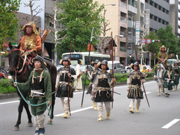
Procession of Military Officers in the Enryaku Period
-
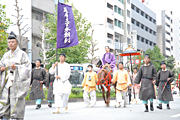
Procession of Civil Official in the Enryaku Period
-

Shinko Procession
-

Procession of ‘Shirakawa-me’
-

Procession of ‘Kyusen-kumi’
※当サイトに掲載の内容はすべて掲載時点での情報です。変更となる可能性がありますので、お出掛けの際は念の為事前にご確認ください。



